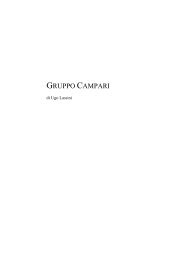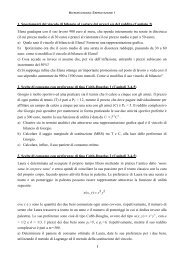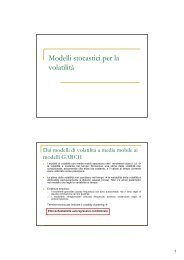Teoria della selezione del portafoglio e modelli di equilibrio del ...
Teoria della selezione del portafoglio e modelli di equilibrio del ...
Teoria della selezione del portafoglio e modelli di equilibrio del ...
Create successful ePaper yourself
Turn your PDF publications into a flip-book with our unique Google optimized e-Paper software.
⎛ RG<br />
a − R ⎞<br />
In<strong>di</strong>ce <strong>di</strong> Sharpe = ⎜<br />
RF a<br />
⎟<br />
⎜<br />
⎟<br />
⎝ σ Ra<br />
⎠<br />
Molto <strong>di</strong>ffusa è la versione con il ren<strong>di</strong>mento me<strong>di</strong>o annuo invece che quello geometrico;<br />
si ritiene più corretta questa in<strong>di</strong>cazione <strong>del</strong> ren<strong>di</strong>mento.<br />
In<strong>di</strong>ce <strong>di</strong> Sortino<br />
Un’altra misura <strong>di</strong> rischio/ren<strong>di</strong>mento, rappresenta il sovra-ren<strong>di</strong>mento per unità <strong>di</strong><br />
volatilità negativa (la volatilità dei soli ren<strong>di</strong>menti negativi). Il sovra-ren<strong>di</strong>mento può<br />
essere calcolato rispetto al benchmark o rispetto all’attività priva <strong>di</strong> rischio.<br />
RG a = Ren<strong>di</strong>mento me<strong>di</strong>o geometrico annualizzato<br />
RRF a = Ren<strong>di</strong>mento annuo <strong>del</strong>l’attività “Risk Free” (Euribor a 3 mesi )<br />
σ DRa = Downside Deviation<br />
⎛ R<br />
In<strong>di</strong>ce <strong>di</strong> Sortino = ⎜ Ga<br />
− R<br />
⎜<br />
⎝ σDRa<br />
RF<br />
a ⎞<br />
⎟<br />
⎠<br />
In<strong>di</strong>ce <strong>di</strong> Mo<strong>di</strong>gliani<br />
E’ un in<strong>di</strong>ce che permette <strong>di</strong> confrontare asset con lo stesso obiettivo d’investimento<br />
(medesimo benchmark) portandoli ad un uguale livello <strong>di</strong> rischio, cioè variando la loro<br />
rischiosità fino a farla coincidere con quella <strong>del</strong> benchmark e in seguito calcolando il<br />
ren<strong>di</strong>mento <strong>del</strong>l’asset mo<strong>di</strong>ficato.<br />
In pratica, per ciascun asset con un dato rischio e ren<strong>di</strong>mento, la misura <strong>di</strong> Mo<strong>di</strong>gliani<br />
determina il ren<strong>di</strong>mento che l’asset avrebbe avuto se avesse assunto lo stesso livello <strong>del</strong><br />
rischio <strong>del</strong> Benchmark. E’ analogo all’in<strong>di</strong>ce <strong>di</strong> Sharpe, ma mentre il primo rappresenta un<br />
“coefficiente”, l’in<strong>di</strong>ce <strong>di</strong> Mo<strong>di</strong>gliani è espresso con un valore percentuale, è cioè un “<br />
ren<strong>di</strong>mento”.<br />
RG a = Ren<strong>di</strong>mento me<strong>di</strong>o geometrico annualizzato<br />
σ Ra<br />
= Standard Deviation annualizzata<br />
a<br />
RD<br />
σ = Standard Deviation <strong>del</strong> Benchmark annualizzata<br />
RRF a = Ren<strong>di</strong>mento annuo <strong>del</strong>l’attività “Risk Free” (Euribor a 3 mesi )<br />
σ RDa<br />
* RRF a<br />
σ a<br />
In<strong>di</strong>ce <strong>di</strong> Mo<strong>di</strong>gliani = ( R a − R a)<br />
+<br />
G<br />
RF<br />
R<br />
Information Ratio<br />
E’ una misura che mostra quanto rischio aggiuntivo, rispetto al benchmark, il gestore ha<br />
assunto al fine <strong>di</strong> produrre un determinato <strong>di</strong>fferenziale <strong>di</strong> ren<strong>di</strong>mento.<br />
ER a = Mean Excess Return annualizzato<br />
TEVa =Tracking Error Volatility annualized<br />
ERa<br />
Information Ratio =<br />
TEVa<br />
134
















